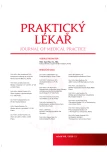Overweight and obesity in children in relation to physical activity and excessive body weight in their parents
Authors:
E. Sigmund 1; P. Baďura 1,2; D. Sigmundová 1
Authors‘ workplace:
Univerzita Palackého v Olomouci, Fakulta tělesné kultury, Institut aktivního životního stylu, Vedoucí: Mgr. František Chmelík, Ph. D.
1; Univerzita Palackého v Olomouci, Fakulta tělesné kultury, Katedra rekreologie, Vedoucí: Mgr. Zdeněk Hamřík, Ph. D.
2
Published in:
Prakt. Lék. 2020; 100(2): 83-87
Category:
Of different specialties
Overview
Objective: The main objective of this study was to identify the relationship between overweight/obesity in children and objectively monitored physical activity (PA), active participation in organized leisure-time PA, entertaining screen time (ST), and the level of body weight in their parents in a representative group of 1,101 Czech families.
Methods: The analysis included 1,101 parent-child pairs (648 mother-child and 453 father-child) with complete body weight status data, entertainment ST, PA, and participation in organized leisure-time PA monitored using a Yamax pedometer during regular school/work week during spring and autumn between 2013 and 2019. Logistic regression analysis was used to quantify the odds ratio of childhood overweight/obesity and parents’ lifestyle indicators (overweight/obesity, ≥ 10,000 steps a day, ≤ 2 hours of entertainment ST daily, active participation (≥ 1 a week) in organized leisure-time PA).
Results: Mothers’ excessive body weight significantly (more than 2.5 times p < 0.001) increased the odds ratio of overweight/obesity in their offspring, while active participation of fathers in organized leisure-time PA and achieving 10,000 steps a day significantly (p < 0.05) reduced the odds ratio of overweight/obesity in their children.
Conclusions: The cumulative effect of parental active involvement in organized leisure-time PA and achieving 10,000 steps a day is a natural means of preventing overweight/obesity in their offspring due to family ties.
Keywords:
overweight/obesity – daily step counts – organized leisure-time physical activity – entertainment screen time
Sources
1. Inchley J, Currie D, Young T, et al. Adolescent obesity and related behaviours: Trends and inequalities in the WHO European Region, 2002–2014. Copenhagen: WHO Regional Office for Europe 2017 [online]. Dostupné z: http://www.euro.who.int/_data/assets/pdf_file/0019/339211/WHO_ObesityReport_2017_v3.pdf?ua=1 [cit. 25-11-2019].
2. Abarca-Gómez L, Abdeen ZA, Hamid ZA, et al. Worldwide trends in body-mass index, underweight, overweight, and obesity from 1975 to 2016: a pooled analysis of 2416 population-based measurement studies in 128.9 million children, adolescents, and adults. Lancet 2017; 309(10113): 2627–2642 [online]. Dostupné z: https://dx.doi.org/10.1016/S0140-6736(17)32129-3 [cit. 25-11-2019].
3. Beets MW, Brazendale K, Weaver RG, et al. Rethinking behavioural approaches to compliment biological advances to understand the etiology, prevention, and treatment of childhood obesity. Child Obes 2019; 15(6): 353–358.
4. Matwiejczyk L, Mehta K, Scott J, et al. Characteristics of effective interventions promoting healthy eating for pre-schoolers in childcare settings: An umbrella review. Nutrients. 2018; 10(3): 293 [online]. Dostupné z: https://www.mdpi.com/2072-6643/10/3/293/htm [cit. 25-11-2019].
5. Erkelenz N, Kobel S, Kettner S, et al. Parental activity as influence on children’s BMI percentiles and physical activity. J Sports Sci Med 2014; 13(3): 645–650.
6. Bringolf-Isler B, Schindler C, Kayser B, et al. Objectively measured physical activity in population-representative parent-child pairs: parental modelling matters and is context-specific. BMC Public Health 2018; 18: 1024 [online]. Dostupné z: https://dx.doi.org/10.1186/s12889-018-5949-9 [cit. 25-11-2019].
7. Sigmundová D, Sigmund E, Badura P, et al. Parent-child behavioural patterns related to pre-schoolers’ overweight/obesity. Acta Gymnica 2017; 47(2): 53–63 [online]. Dostupné z: https://dx.doi.org/10.5507/ag.2017.012 [cit. 26-11-2019].
8. Sigmund E, Baďura P, Vokáčová J, a kol. Vztah pohybové aktivity rodičů a jejich dětí v českých rodinách s dětmi s normální tělesnou hmotností a dětmi s nadváhou/obezitou. Prakt. Lék. 2018; 98(2): 73–80.
9. Bassett DRJr, Toth LP, LaMunion SR, et al. Step counting: a review of measurement considerations and health-related applications. Sports Med 2017; 47(7): 1303–1315 [online]. Dostupné z: https://dx.doi.org/10.1007/s40279-016-0663-1 [cit. 28-11-2019].
10. WHO. Obesity and overweight. Fact sheet No 311 [online]. Dostupné z: http://www.who.int/mediacentre/factsheets/fs311/en/ [cit. 29-11-2019].
11. Tudor-Locke C, Craig C, Beets M, et al. How many steps/day are enough? For children and adolescents. Int J Behav Nutr Phys Act 2011; 8: 78 [online]. Dostupné z: https://dx.doi.org/10.1186/1479-5868-8-78 [cit. 29-11-2019].
12. Tremblay MS, LeBlanc AG, Kho ME, et al. Systematic review of sedentary behaviour and health indicators in school-aged children and youth. Int J Behav Nutr Phys Act 2011; 8: 78 [online]. Dostupné z: https://dx.doi.org/10.1186/1479-5868-8-98 [cit. 29-11-2019].
13. Sigmund E, Baďura P, Sigmundová D, a kol. Trendy a koreláty obezity českých adolescentů ve vztahu k socioekonomickému statusu rodin mezi lety 2002–2018. Prakt. Lék. 2019; 99(4): 147–153.
14. Jääskeläinen A, Pussinen J, Nuutinen O, et al. Intergenerational transmission of overweight among Finnish adolescents and their parents: a 16 years follow-up study. Int J Obes (Lond) 2011; 35(10): 1289–1294 [online]. Dostupné z: https://dx.doi.org/10.1038/ijo.2011.150 [cit. 29-11-2019].
15. Frelich J. Průměrný věk matek se zvyšuje ve všech krajích. Statistika & My 2018; 8(9): 34–35.
Labels
General practitioner for children and adolescents General practitioner for adultsArticle was published in
General Practitioner

2020 Issue 2
Most read in this issue
- General overview of percutaneous endoscopic gastrostomy
- Anxiety of pregnant women – importance, risk factors, consequences
- Standard, neglected and new information about compression therapy with bandages
- Thyroid cancers
